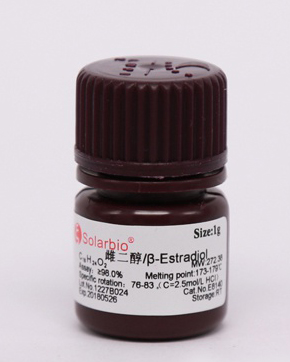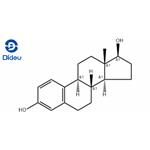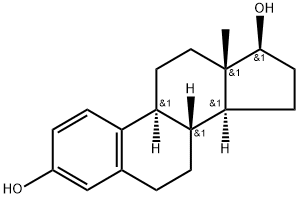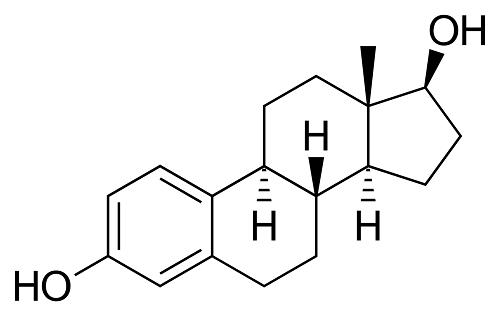Synthesis of β-estradiol
Introduction
β-estradiol is white or milky white leaf-like or needle-like crystals (ethanol solution), odorless. β-estradiol is stable in air[1]. The refractive index of β-estradiol is 80.4°. β-estradiol is easily soluble in ethanol, soluble in acetone, dioxane and alkali solution, and slightly soluble in vegetable oil.

Picture 1 One bottle of β-estradiol
β-estradiol, also known as "estrogen", "couture hormone". A type of β-estrogen. The most content and the strongest activity. Secreted by granulosa cells of ovarian follicles. Its metabolites are estrone and estriol. Contains 18 carbon atoms. The target organs are the uterus, vagina, fallopian tubes and pituitary gland. It is an estrogen therapy that is absorbed through the skin. Supplements the lack of 17-β-estradiol secreted by women's ovaries, while avoiding the side effects (breast pain, weight gain, high blood pressure, gallstones and abnormal liver function, etc.) caused by oral administration. Estrogen can induce cells to synthesize DNA, RNA and various proteins in corresponding tissues. β-Estradiol, commonly used in biology to study cell differentiation and transformation (oncogenesis).
Properties
The role of β-estrogen can promote the development of secondary sexual characteristics and the final formation of sexual organs in underage girls. In adult women, in addition to maintaining the above-mentioned secondary sexual characteristics, a series of changes in the endometrium can occur, resulting in periodic menstruation[2]. It also increases the activity of the uterus and fallopian tubes, and increases the sensitivity of the uterine muscle to oxytocin. In addition, estrogen can increase the deposition of calcium salts in bones, accelerate the closure of epiphysis, and increase serum triglycerides and phospholipids in large doses, causing water and sodium retention. At higher doses, estrogen can also act on the hypothalamic-pituitary system, inhibit the secretion of gonadotropins and prolactin, and counteract the main effect of androgens.
Synthesis of β-Estradiol
Unlike neurotransmitters, which are synthesized and stored in vesicles and then released, steroid hormones are synthesized and released immediately upon stimulation. The synthesis of steroid sex hormones begins with the breakdown of cholesterol into progesterone, followed by the breakdown of testosterone and androstenedione, which are converted into estradiol (by aromatase) and β-estrone, respectively. They are mainly synthesized in the gonads and act paracrinely on adjacent cells or, via the blood, endocrine on distant tissues. Aromatase is also widely expressed in the brain, and it produces estradiol locally in the hypothalamus and hippocampus, acting on neighboring cells in a paracrine fashion or through synapses.
When culturing female rat hippocampal neurons in vitro, after adding the aromatase inhibitor letrozole, it was found that the density of dendritic spines was reduced, the expression of synaptic proteins was reduced, and the long-term potentiation of synapses was inhibited. This was also found in experiments with ovariectomized in vivo injections. In addition, estradiol synthesis there is also regulated by neuronal activity: increased estradiol synthesis was found after activation of N-methyl-D-aspartate (NMDA) receptors in hippocampal neurons cultured in vitro. Further, β-estradiol at this location is related to spatial memory: letrozole was injected into the dorsal hippocampus of anaplastic hermaphrodites, and the aromatase inhibitor androsta-1,4 was implanted in the hippocampus of male zebra finch. 6-triene-3,17-dione (ATD), which was found in experiments with oral letrozole in marmoset monkeys of both sexes. Aromatase expressed in the hippocampus may also regulate memory: women taking letrozole for estrogen receptor-positive breast cancer showed deficits in episodic memory.
The role of β-estradiol in pregnancy
Research shows that estrogen plays an important role in maintaining pregnancy. It plays an important role in the preparation of the endometrium before embryo implantation and the maintenance of the luteal phase. Β-estradiol levels in early pregnancy can reflect the quality of the dominant follicle and the function of the corpus luteum in the ovary, and a rapid rise in β-estradiol levels reflects a healthy and viable fetal placental functional unit. Moreover, the value of β-estradiol within 24 hours is relatively stable, which has important detection significance.
Studies by Salazar et al. further showed that low levels of estrogen can inhibit the expression of progesterone receptors in decidual tissue, and even if progesterone levels are normal, they cannot exert their due physiological effects, resulting in poor decidual development, embryo malnutrition and stillbirth. or miscarriage, so the use of β-estradiol levels to predict pregnancy outcomes is of great significance. According to Fu Jinhua's outpatient testing statistics: at 12 weeks of pregnancy, if the naked β-estradiol value does not reach 2000pmol/l, even if there is a fetal heartbeat, the prognosis is very poor, and it is very likely that the pregnancy will stop. If β-estradiol levels are low after 12 weeks of gestation, fetal growth restriction in the second and third trimesters is common.
Reference
1 Chen Zijiang. The application of estrogen in gynecological endocrine diseases [M]. Beijing: Tsinghua Tongfang CD-ROM Electronic Press, 2012: 1-6.
2 Sun Zhikun, Pan Jing, Yang Hongqi, etc. The role of PI3K-Akt pathway in Aβ-induced apoptosis. Chinese Journal of Pathophysiology, 2009, 25(1): 84-88.
Related articles And Qustion
See also
Lastest Price from β-Estradiol manufacturers

US $0.00-0.00/KG2025-11-24
- CAS:
- 50-28-2
- Min. Order:
- 1KG
- Purity:
- 98
- Supply Ability:
- 10000KGS

US $200.00/g2025-11-24
- CAS:
- 50-28-2
- Min. Order:
- 100g
- Purity:
- 99
- Supply Ability:
- 999




